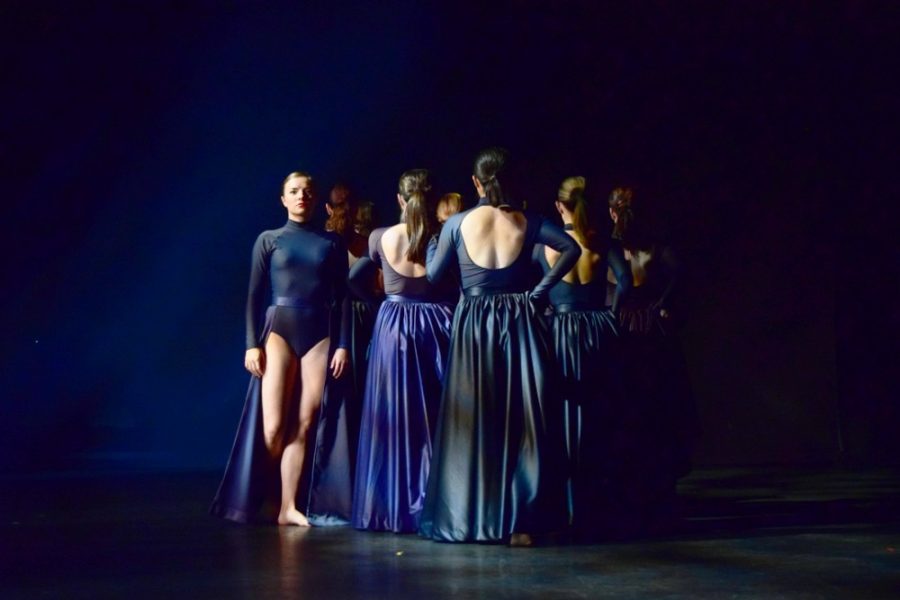The School of Dance ushers in the colorful and vibrant season of spring with its performance of “Color Wheel.”
The creative minds of the faculty at the School of Dance make “Color Wheel” a masterpiece. However, the performance elevated to a new level of prestige with its incorporation of George Balanchine’s “Tchaikovsky Pas de Deux.”
Before the performance started on Wednesday night, Melissa Lowe, director of the School of Dance, walked on stage with Edward Villella, a former New York City Ballet principal dancer. After dancing under the great Balanchine himself, Villella knows the complexities of the “Tchaikovsky Pas de Deux” from first-hand experience as the male lead. Villella came to the School of Dance to work with the students as they learned the choreography and inspire them to connect deeper with the movements.
“[‘Tchaikovsky Pas de Deux’] is a delight to watch and a delight to dance,” Villella said.
As the show begins with Balanchine’s famous piece, Villella’s words transport audience members back to the 1960s when he first started performing the dance. Audience members can appreciate the enduring choreography and story as they see the young UA dancers imprint their generation onto the timeless steps. From Diane Diamond’s precise footwork on pointe to Maxwell Foster’s soaring leaps, the couple that performed in Wednesday’s show honored the legacy of the “Tchaikovsky Pas de Deux” with their strong partnering, technique and performance.
Styles changed from ballet to jazz with “Distant Hearts,” choreographed by Michael Williams, a professor at the School of Dance.
“Interestingly, I tried to be a dual personality,” Williams said. “I tried to be myself as a choreographer while I [wanted] to darkly imagine myself as Tim Burton, the movie director.”
The piece features three couples — all clad in black costumes with green, glow-in-the-dark chest accents. The men and women danced in front of a screen projecting vibrant colors of light, and they constantly connected with and passed around three glittery spheres; the meaning of the spheres was left to the audience’s interpretation. The costumes, visuals and movements established a futuristic atmosphere — focusing on love set somewhere far off in the galaxies. The piece juxtaposed animalistic and primal movements with futuristic ones and was performed by many powerhouse dancers.
Following “Distant Hearts” was Tamara Dyke-Compton’s piece “False Front.”
“‘False Front’ has one female cast and one male cast,” said Dyke-Compton, an assistant professor at the School of Dance. “This piece explores the nature of an outsider and the masks they wear to blend in. I wanted to create a piece that had non-gender specific movement and explore the variations that naturally occur between a male cast and a female cast.”
The Wednesday performance featured the male cast while other showings will feature the female cast. The piece started out with a group of men — all wearing long satin skirts — in a close-knit block formation walking upstage. As the group moved almost flawlessly in sync with each other, one man would break apart and do a small solo. Each solo would only last a few seconds but would show the dancer experiencing a reckless freedom with his body — as if he was being let out of a cage where he had been imprisoned for years. Overall, the male cast was breath-taking, and the symbolism of the piece was enlightening.
After intermission, Douglas Nielsen’s piece “If You Don’t Leave Me, I’ll Find Someone Who Will” took the stage.
“[It] is a dance with 10 episodes about love — aspects of love that help express our human need [to] be needed, to make eye contact and most of all to trust someone enough to let them go,” said Nielsen, a professor at the School of Dance.
Nielsen’s piece, danced to songs on his iPod containing the word love, is wonderfully multi-faceted and offers indelible imagery portraying different stories of love. The dancers performed sign language to the lyrics of “All You Need is Love” by The Beatles which started and ended the piece; an American Sign Language interpreter accompanied Nielsen’s entire dance. Nielsen collaborated with Bill Dambrova, Arizona visual artist, to paint wooden boxes to be used in different capacities throughout the piece; in a pivotal moment in the dance, the boxes were used to build a ladder from which one of the female dancers fell into the arms of the other cast members.
“Con Spirito,” choreographed by James Clouser, ended the show with high spirits.
“It’s a really bright and vibrant ballet,” said Madison Kilby, a junior studying dance and biological anthropology . “It’s really fun to dance, and it’s an honor … because it’s been performed by so many professional ballet companies.”
“Color Wheel” is another engaging performance to add to the School of Dance’s collection, and certain to impart the vibrancy of its dances on the audience. The show runs until Sunday at the Stevie Eller Dance Theatre.
_______________
Follow Madison Scavarda on Twitter.









